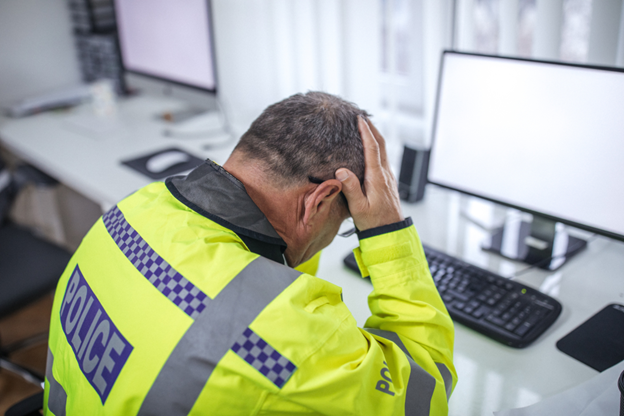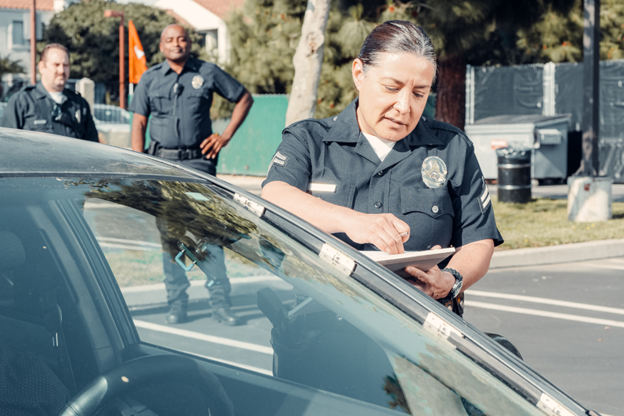Law Enforcement Burnout: A Complete Guide (2025)
Reduce law enforcement burnout with secure, 99% accurate human transcription. Fast turnaround, CJIS-compliant, and built for officers who need reports—fast.

Your shift just ended, but the work isn’t over. The reports are piling up, your mind is exhausted, and tomorrow promises more of the same.
You joined law enforcement to protect and serve—not to drown in paperwork, stress, and sleepless nights. But the burnout is real, and it’s affecting your quality of life. How much longer can you run on empty?
Law enforcement burnout is a crisis. It’s time to take back control. Let’s talk about what’s causing it—and how to stop it before it’s too late.
What is Law Enforcement Burnout?
Law enforcement burnout is the physical, emotional, and mental exhaustion that results from prolonged stress on the job. The National Library of Medicine classifies burnout as an occupational phenomenon.
Fueled by long shifts, high-stakes situations, and relentless public scrutiny, officers experience burnout, and it spills into their personal lives. This leads to strained relationships, health issues, like chronic fatigue, and career dissatisfaction.
Common Causes of Burnout in Law Enforcement

53.6% of active officers report experiencing burnout during their careers. Let that sink in—most law enforcement professionals reach a breaking point.
Burnout is a leading reason officers leave the force, yet the policing culture still glorifies endurance at any cost. Here’s why burnout is hitting law enforcement harder than ever.
● Officers face life-or-death decisions daily.
Policing is unpredictable and high-stakes. Officers never know if a routine traffic stop will escalate into a critical situation. The constant need for vigilance and rapid decision-making leads to chronic stress and fatigue.
● Mandatory overtime leaves no room for recovery.
Staffing shortages mean officers work back-to-back shifts, leaving little time for rest or personal life. Exhaustion builds, and mistakes happen. Without proper recovery, mental and physical health decline.
● The emotional toll is overwhelming.
Officers witness violence, loss, and human suffering daily. Processing these experiences is difficult; many suppress their emotions to stay “tough.” Without proper coping mechanisms, trauma accumulates and contributes to burnout.
● The public eye never blinks.
Law enforcement is under constant scrutiny. The pressure to make split-second decisions while being filmed, analyzed, and judged intensifies stress. Officers feel like they can never make a mistake, adding another layer of anxiety.
● Paperwork piles up.
Contrary to TV dramas, policing isn’t just action-packed fieldwork. Officers spend hours transcribing reports, statements, and case files. This administrative burden eats into rest time, increasing stress levels and frustration.
6 Warning Signs of Police Burnout
Burnout doesn’t happen overnight—it builds over time. You may not recognize the signs until it’s too late. Here are six red flags that burnout is taking hold.
#1. Extreme Fatigue —That Doesn’t Go Away
Feeling exhausted after a long shift is normal. But if exhaustion lingers even after rest, it’s a sign of chronic stress. Officers experiencing burnout often struggle to stay alert, making split-second decisions even more difficult.
#2. Increased Irritability and Short Temper
Burnout often manifests as frustration with colleagues, supervisors, or the public. Officers may react angrily to minor issues or lose patience faster than usual.
#3. Emotional Numbness or Detachment
One of the most concerning signs of burnout is emotional disengagement. Officers who once felt empathy and dedication may start feeling indifferent to their work, the people they serve, or even their own well-being.
#4. Physical Symptoms and Frequent Illness
Chronic stress weakens the immune system. Headaches, stomach issues, muscle tension, and frequent colds or infections can all be signs that the body is under too much strain.
#5. Difficulty Sleeping or Unusual Sleep Patterns
Burnout disrupts normal sleep cycles. Some officers struggle with insomnia, replaying stressful encounters in their minds. Others may oversleep, using exhaustion as an escape from stress.
#6. Loss of Passion for the Job
Many officers join the force with a strong sense of purpose. When burnout sets in, that passion fades. A job that once felt meaningful now feels like just another shift to get through.
Impact of Burnout on Law Enforcement Officers and Communities

Burnout in law enforcement is a public safety crisis. Burnout is felt beyond the four walls of a precinct and created widespread consequences:
Higher Turnover and Recruitment Struggles
Burnt-out law enforcement officers are leaving the force in record numbers. With fewer recruits stepping up to replace them, agencies face growing staffing shortages. The result? Heavier workloads on remaining officers, increasing stress, fueling an endless burnout cycle.
Reduced Officer Performance and Decision-Making
Exhaustion and emotional fatigue impact an officer’s ability to assess situations accurately. Slower response times, impaired judgment, and increased mistakes in high-pressure moments put both officers and civilians at risk.
More Use-of-Force Incidents and Community Strain
Studies show that stress and burnout contribute to higher rates of excessive force incidents. When officers are emotionally drained, patience wears thin, and interactions with the public become more volatile—damaging community trust.
Declining Mental and Physical Health Among Officers
Unmanaged burnout leads to serious health consequences, including high blood pressure, heart disease, and increased substance abuse rates. Officers struggling with burnout are also more likely to experience PTSD, depression, and suicidal thoughts.
Decreased Public Safety and Response Times
Understaffed departments mean fewer officers available to respond to emergencies. When burnout drives officers away from the profession, communities feel the impact through longer wait times and reduced patrol presence.
Strategies for Firms to Prevent and Reduce Burnout
Burnout in law enforcement isn’t inevitable—agencies that prioritize officer well-being, decrease workloads, and lean into technology will significantly reduce stress and improve retention. Here’s how:
● Take Wellness Programs Seriously
A strong wellness program goes beyond basic EAPs (Employee Assistance Programs). Departments need proactive mental health resources, peer support groups, and regular check-ins to help officers process the emotional weight of the job.
Encouraging fitness, counseling, and resilience training will make a measurable difference in stress levels.
● Work with a Transcription Company to Save Hours of Time
Officers spend hours each week manually typing reports, summarizing documents, and case notes—valuable time that could be spent on patrol or investigative work.
- Partnering with a law enforcement transcription service eliminates this burden by converting recorded interviews, dictations, and reports into formatted, ready-to-use evidence transcripts.
- Clio Integration: SpeakWrite’s integration allows officers to submit audio files directly within their case management system and receive transcribed reports without extra steps.
- Enterprise Accounts: Large agencies can benefit from Enterprise Transcription Accounts, providing bulk submission capabilities, centralized billing, and streamlined report processing for an entire department.
● Automate Systems to Reduce Administrative Work
Law enforcement agencies are turning to automation to handle time-consuming tasks. Automating report filing, incident documentation, and case tracking reduces paperwork and allows officers to focus on law enforcement—not office work.
Best Practices for Burnout Police Officers
While your place of employment should be looking for ways to decrease your mental and physical stressors. It’s important to take your mental health in your own hands. Try a few of these ideas as a good place to start:
- Set boundaries with work and take scheduled days off seriously.
- Prioritize sleep and nutrition to maintain energy and focus.
- Use stress management techniques like deep breathing and exercise.
- Seek support from peers, supervisors, or mental health professionals.
- Take vacation time to reset and prevent emotional exhaustion.
- Limit exposure to trauma off duty by avoiding excessive crime-related content.
- Streamline reports and admin work with transcription services.
- Engage in hobbies and activities outside of law enforcement.
- Stay physically active to reduce stress and improve mental well-being.
- Recognize early signs of burnout and take action before it worsens.
SpeakWrite Difference
SpeakWrite gives law enforcement the best of the best—fast, human-verified transcription with 99% accuracy, built for the demands of police officers and investigators.
100% Human Transcription for Law Enforcement Accuracy
AI transcription tools can’t always handle law enforcement terminology, multiple speakers, or the nuances of interviews and reports. SpeakWrite uses professional human transcriptionists trained in police documentation, so no endless revisions are required.
Fast Turnaround, Even on Tight Deadlines
Police work moves fast, and officers don’t have time to wait days for a transcript. SpeakWrite delivers completed transcriptions in as little as three hours, allowing departments to keep cases moving without delays.
Secure, Confidential, and CJIS-Compliant
SpeakWrite is built for secure, encrypted transcription services that meet the strictest law enforcement standards. With strict confidentiality agreements and secure file handling, agencies can trust that sensitive case information stays protected.
Seamless Integration with Legal Workflows
SpeakWrite is designed to fit into the way officers already work. Law enforcement personnel can submit recordings via a mobile app, web portal, or even a dedicated dictation line. Finished transcripts are delivered in an easy-to-use format, ready for case files, reports, or courtroom submission.
Reduce Burnout with SpeakWrite’s Clio Integration
Managing police reports and case documentation is already a full-time job. Adding transcription to the mix? That’s a recipe for burnout. SpeakWrite’s integration with law enforcement case management systems helps officers and investigators cut down on paperwork and focus on policing.
Step 1: Submit Transcriptions Directly from Your System
No more downloading and re-uploading files. SpeakWrite’s integration allows officers to submit audio recordings directly from their case management platform, keeping everything in one secure system.
Step 2: Receive Case-Ready Transcripts Automatically
Once SpeakWrite’s law enforcement transcriptionists complete the document, it is automatically sent back to the correct case file—accurate, formatted, and ready for review.
Step 3: Improve Case Management Without Extra Effort
Transcription is about making police work more efficient. With SpeakWrite and case management systems working together, officers can:
- Dictate reports and have them transcribed instantly.
- Keep interviews and witness statements organized.
- Save hours on documentation and focus on investigations.
Looking Forward: Combatting Burnout in the Industry
As law enforcement agencies continue to grapple with burnout, the future of officer wellness will rely on proactive strategies, better technology, and systemic change.
Departments must move beyond reactive measures and instead implement long-term solutions that prioritize officer well-being before burnout takes hold.
One major shift will be the integration of mental health and wellness programs directly into law enforcement training. Future officers won’t just learn tactical skills—they’ll be trained in stress management, emotional resilience, and mindfulness techniques.
Agencies will also adopt mandatory wellness check-ins, so officers have regular opportunities to discuss stress, seek counseling, and address burnout before it escalates.
Technology will also play a growing role in combating burnout. AI-powered reporting tools, automated transcription services, and mobile-friendly case documentation will continue to reduce administrative burdens.
Officers will spend less time on reports and more time focusing on community safety, investigations, and proactive policing.
Cultural change within law enforcement agencies will be essential. Leadership must shift from a “tough it out” mentality to one that normalizes mental health support, flexible scheduling, and work-life balance.
The departments that make these changes will retain more officers, improve public trust, and build stronger, more resilient teams.
Law Enforcement Burnout: Frequently Asked Questions
What is police trauma syndrome?
Police trauma syndrome is a condition where officers experience long-term psychological distress due to repeated exposure to violence, high-stress situations, and traumatic incidents. It can lead to PTSD, anxiety, depression, and difficulty maintaining personal relationships.
Why are people leaving law enforcement?
Officers are leaving law enforcement due to burnout, high-stress work environments, long hours, low morale, public scrutiny, and lack of departmental support. Many seek better work-life balance, career growth, or jobs with less emotional and physical strain.
Is a police officer the most stressful job?
Yes, policing is considered one of the most stressful jobs due to constant exposure to danger, life-or-death decisions, unpredictable shifts, and emotional strain. Officers often face high-pressure situations, leading to chronic stress and burnout.
How do cops handle stress?
Police officers handle stress through physical fitness, peer support, mental health counseling, mindfulness techniques, and work-life balance strategies. Departments may also offer wellness programs, stress management training, and access to professional therapy.
Protect Your Team from Burnout—Start with SpeakWrite

Long hours and nonstop stress take a toll on law enforcement. The right tools can lighten the load. SpeakWrite streamlines report transcription, so officers can focus on what matters most—serving their communities.
